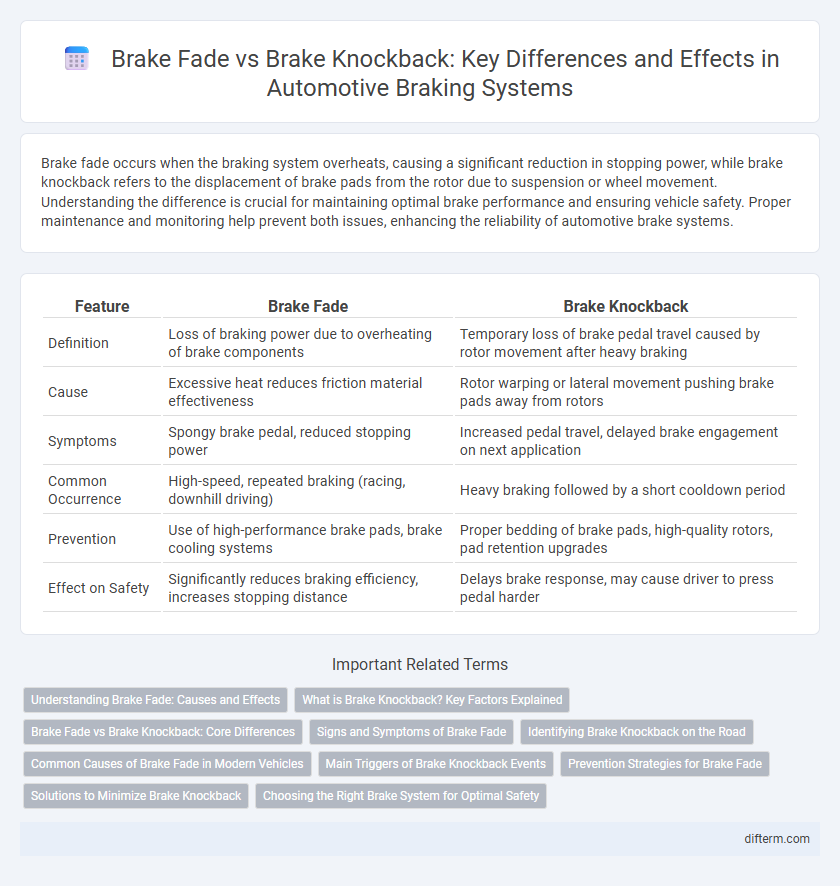Brake fade occurs when the braking system overheats, causing a significant reduction in stopping power, while brake knockback refers to the displacement of brake pads from the rotor due to suspension or wheel movement. Understanding the difference is crucial for maintaining optimal brake performance and ensuring vehicle safety. Proper maintenance and monitoring help prevent both issues, enhancing the reliability of automotive brake systems.
Table of Comparison
| Feature | Brake Fade | Brake Knockback |
|---|---|---|
| Definition | Loss of braking power due to overheating of brake components | Temporary loss of brake pedal travel caused by rotor movement after heavy braking |
| Cause | Excessive heat reduces friction material effectiveness | Rotor warping or lateral movement pushing brake pads away from rotors |
| Symptoms | Spongy brake pedal, reduced stopping power | Increased pedal travel, delayed brake engagement on next application |
| Common Occurrence | High-speed, repeated braking (racing, downhill driving) | Heavy braking followed by a short cooldown period |
| Prevention | Use of high-performance brake pads, brake cooling systems | Proper bedding of brake pads, high-quality rotors, pad retention upgrades |
| Effect on Safety | Significantly reduces braking efficiency, increases stopping distance | Delays brake response, may cause driver to press pedal harder |
Understanding Brake Fade: Causes and Effects
Brake fade occurs when excessive heat reduces the friction between brake pads and rotors, leading to diminished stopping power and increased stopping distance. This phenomenon is commonly caused by prolonged braking or aggressive driving, which raises the brake system temperature beyond optimal levels. Understanding brake fade is crucial for maintaining vehicle safety and preventing potential accidents during high-demand braking situations.
What is Brake Knockback? Key Factors Explained
Brake knockback occurs when the brake caliper piston is pushed back into its bore, increasing pedal travel and reducing braking efficiency. Key factors include rough terrain or aggressive driving, which cause suspension movement that displaces the brake pads from the rotor. This issue results in the need to reapply the brakes firmly to restore normal pedal feel and stopping power.
Brake Fade vs Brake Knockback: Core Differences
Brake fade occurs due to excessive heat buildup in the brake system, leading to reduced friction and diminished stopping power. Brake knockback, on the other hand, is caused by suspension movement pushing the brake pads away from the rotor, resulting in a spongy pedal feel and increased pedal travel. Understanding these core differences is critical for diagnosing braking issues and improving vehicle safety and performance.
Signs and Symptoms of Brake Fade
Brake fade is characterized by a noticeable decrease in braking power, requiring increased pedal pressure to slow down or stop the vehicle. Common signs include a spongy or soft brake pedal, longer stopping distances, and a burning smell near the wheels due to overheated brake components. Unlike brake knockback, which involves a sudden drop in pedal height after cornering, brake fade results from heat buildup that reduces the friction efficiency of brake pads and rotors.
Identifying Brake Knockback on the Road
Brake knockback occurs when the brake pedal feels low or soft due to the caliper pistons being pushed back into their bores, often caused by aggressive cornering or heavy braking, which temporarily reduces brake pad engagement. Unlike brake fade, which results from overheated brake components losing friction, brake knockback can be identified on the road by a noticeable increase in pedal travel before the brakes engage firmly. Monitoring pedal feel after sharp turns or repeated stops helps distinguish knockback from fade, ensuring timely maintenance and safe braking performance.
Common Causes of Brake Fade in Modern Vehicles
Brake fade in modern vehicles commonly results from excessive heat buildup due to prolonged or aggressive braking, causing the brake pads and rotors to overheat and lose friction efficiency. Contaminants such as water, oil, or brake fluid on the brake components can also reduce braking performance by compromising pad material adhesion. Furthermore, insufficient ventilation around the brake system and the use of low-quality brake pads accelerate the onset of brake fade by failing to dissipate heat effectively.
Main Triggers of Brake Knockback Events
Brake knockback is primarily triggered by wheel or rotor contact during suspension movement, causing the brake pads to be pushed away from the rotor. Other main causes include excessive brake caliper flex or heat expansion of brake components that shift pad position. Understanding these triggers is crucial for diagnosing knockback versus brake fade, where the latter involves brake fluid vaporization or pad glazing.
Prevention Strategies for Brake Fade
Effective prevention strategies for brake fade include using high-performance brake pads with enhanced heat resistance and maintaining adequate cooling through ventilated rotors and proper airflow design. Regular inspection and replacement of brake fluid with high boiling point liquids help prevent moisture contamination and vapor lock, which contribute to fade. Additionally, proper bedding-in procedures and avoiding excessive braking on steep descents reduce the risk of thermal overload and maintain consistent braking performance.
Solutions to Minimize Brake Knockback
Minimizing brake knockback involves using high-quality, properly fitted caliper seals and pistons to maintain consistent brake pad positioning and prevent excessive pad retraction. Upgrading to calipers with anti-knockback features and ensuring precise wheel bearing adjustment helps reduce rotational forces that cause knockback. Regular inspection and maintenance of suspension components and brake hardware further enhance brake system stability and responsiveness.
Choosing the Right Brake System for Optimal Safety
Brake fade occurs when excessive heat reduces braking efficiency, while brake knockback involves pedal travel caused by brake pad displacement during suspension movement. Selecting a brake system with high thermal capacity and precise caliper design minimizes these issues, ensuring consistent stopping power and pedal feel. Prioritize systems featuring advanced cooling techniques and robust pad retention for optimal safety and performance under demanding driving conditions.
brake fade vs brake knockback Infographic

 difterm.com
difterm.com